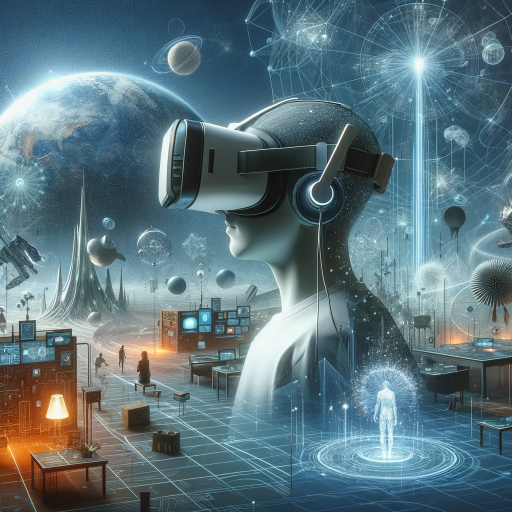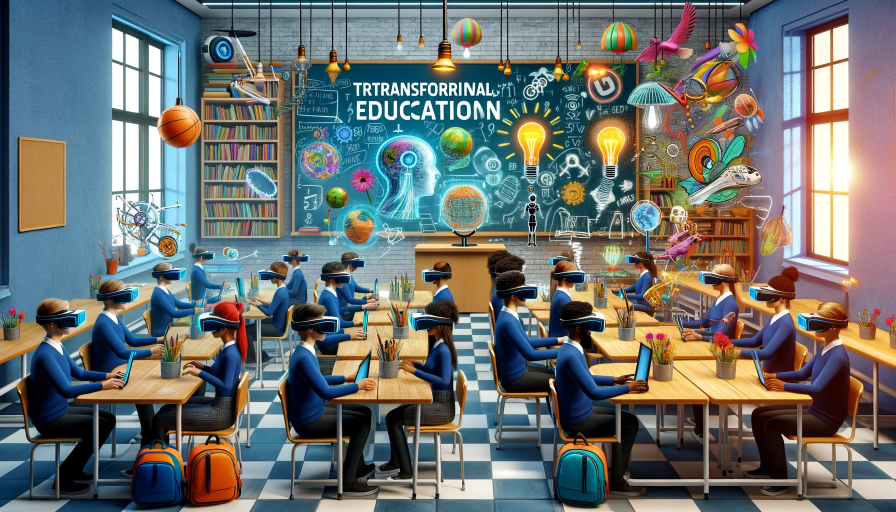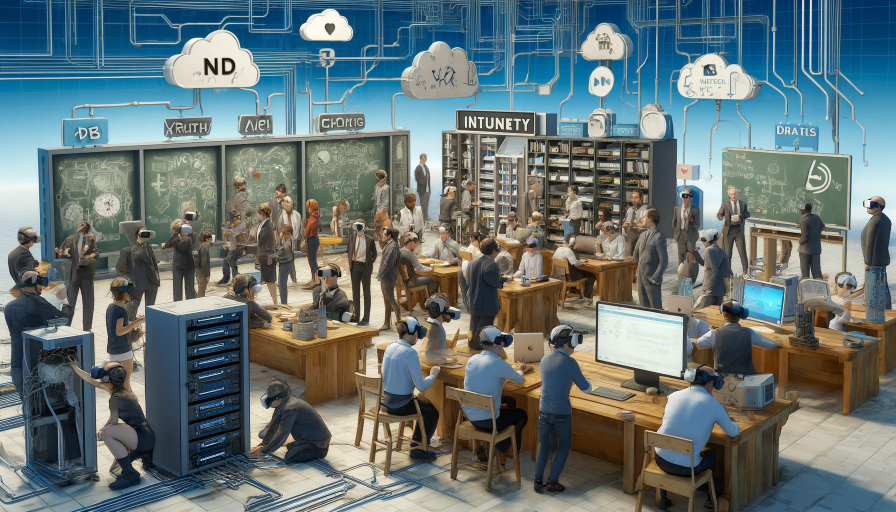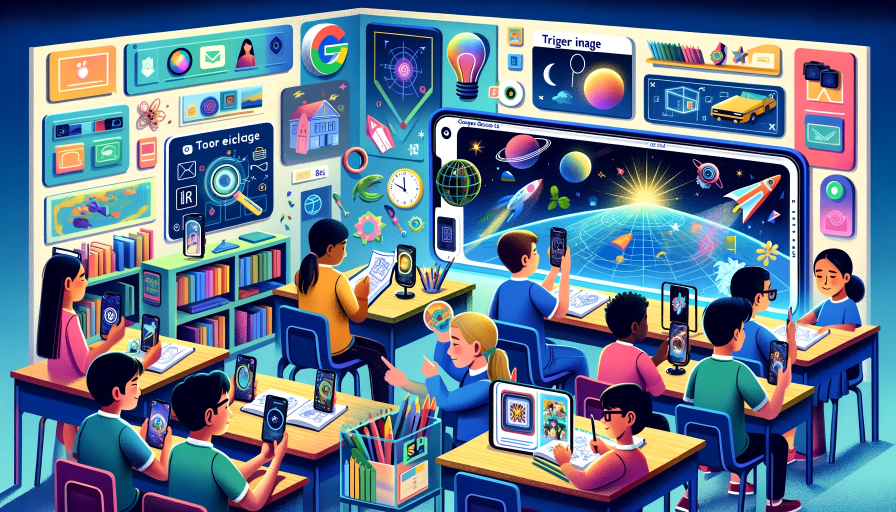Augmented Reality Learn: The Future of Online Learning with AR and VR
Introduction
Introduction to Augmented Reality (AR)
Augmented reality represents a next-generation advancement, enriching our own space with digital elements. Accessible via smartphones, tablets, or specialized AR glasses, this technology enables interactions with 3D models and animations right where we are. Online augmented reality platforms are shaping the future of online learning and transforming sectors such as gaming, healthcare, and real estate by providing immersive experiences.

Introduction to Virtual Reality (VR)
Virtual Reality (VR) creates a fully immersive digital environment, isolating users from the real world and placing them in a completely virtual setting. By wearing VR headsets, users can explore and interact with 3D worlds that simulate real or imagined scenarios. This technology has significant applications in fields like gaming, training simulations, and therapy. In education, VR is revolutionizing the learning experience by providing students with immersive environments where they can practice skills, conduct experiments, and explore new concepts in a controlled, risk-free setting.

Importance of Integrating AR and VR in Online Education
Integrating AR and VR into online education is crucial for several reasons. First, these technologies can significantly enhance student engagement by providing interactive and immersive learning experiences. Traditional online learning methods often lack the engagement and interactivity of physical classrooms. AR and VR can bridge this gap by making online lessons more dynamic and interactive. Second, AR and VR can cater to different learning styles. Visual and kinesthetic learners, in particular, can benefit from the hands-on experiences these technologies offer. Finally, AR and VR can democratize education by making high-quality learning experiences accessible to students worldwide, allowing them to learn at their own pace, regardless of their geographical location.
Understanding AR and VR in Education
Definition and Differences Between AR and VR
Augmented Reality : overlays digital content, such as images, videos, or 3D models, onto the real world. Users can interact with these digital elements through their devices, such as smartphones, tablets, or AR glasses. Augmented Reality enhances the real-world environment with additional information and interactive elements.
Virtual Reality (VR): VR creates a completely immersive digital environment. Users wear VR headsets that block out the real world and immerse them in a virtual space. This space can be anything from a historical setting to a simulated laboratory, allowing for immersive learning experiences.
How AR and VR Are Transforming Traditional Education
augmented and virtual reality are transforming traditional education by providing new ways to engage learners and enhance their understanding of complex subjects. For instance, augmented reality can bring textbooks to life with interactive 3D models or animations that illustrate complex concepts. VR can transport learners to different places and times, offering immersive experiences that are impossible in a traditional classroom setting. These technologies enable experiential learning, where learners can engage through active participation and exploration, rather than just reading or listening.
Benefits of Using augmented and virtual reality in Online Learning
- Enhanced Engagement: AR and VR make courses more engaging by providing interactive and immersive experiences. This increased engagement can lead to better retention and understanding of the material.
- Personalize: These technologies can be used to create personalized course experiences that cater to individual needs and learning styles.
- Practical Experience: AR and VR can simulate real-world scenarios, allowing learners to gain practical experience in a safe and controlled environment. For example, medical trainees can practice surgeries in VR without any risk to patients.
- Accessibility: augmented and virtual reality can make high-quality education accessible to a broad audience, breaking down geographical barriers and providing equal learning opportunities.
- Learn at Your Own Pace: AR and VR allow learners to progress through courses at their own pace, accommodating different learning speeds and schedules. This flexibility ensures that each learner can fully grasp the material before moving on.
online augmented reality course
An online augmented reality course delves into the fundamentals of human-computer interaction, exploring core aspects of this dynamic field. The course provides a comprehensive overview of how augmented reality systems are designed and operated, focusing on the integration of digital and physical realms. Participants gain practical knowledge and theoretical insights, crucial for advancing in the burgeoning field of AR technology.
Current Tools and Platforms for AR and VR Applications
Overview of Existing Tools
Several tools and platforms are currently available to integrate AR and VR into various sectors. Here are some notable examples:
Google Expeditions: This platform offers virtual field trips to various locations around the world. Users can explore museums, historical sites, and natural wonders through VR.
zSpace: zSpace provides an AR/VR platform that offers interactive experiences in areas like science, math, and engineering. Users can dissect virtual animals, explore the human body, and engage in other hands-on activities.
ARKit and ARCore: These are Augmented Reality development platforms by Apple and Google, respectively. They enable the creation of AR applications that allow developers to design interactive experiences.
Oculus Rift and Quest: These VR headsets from Oculus (a subsidiary of Facebook) provide immersive virtual environments. They are used in various settings, from virtual environments to simulated training scenarios.
How These Tools Are Being Used in Educational Settings
These tools are being adopted across various settings to enhance interactive experiences. For example, Google Expeditions allows users to undertake virtual field trips to distant locations. zSpace facilitates virtual dissections and experiments in subjects like science, enhancing engagement. ARKit and ARCore support the development of apps that animate textbooks with interactive 3D models. Oculus headsets are employed in advanced training programs to provide immersive simulations and practical training.
Case Studies of Successful AR/VR Implementations in Schools and Universities
- Case Study 1: A high school in California uses Google Expeditions to enhance its geography and history lessons. Students can virtually visit historical landmarks and geographical locations, making the subjects more tangible and engaging.
- Case Study 2: A medical school in the UK uses Oculus Rift for surgical training. Students can perform virtual surgeries, gaining hands-on experience in a safe and controlled environment.
- Case Study 3: A university in Singapore uses zSpace for engineering courses. Students can interact with 3D models of mechanical components, allowing them to understand complex systems better.
Augmented Reality in Online Courses

Examples of AR Applications in Different Subjects
- Science: Augmented Reality can bring scientific concepts to life by providing interactive 3D models of molecules, cells, and organs. Students can explore these models, conduct virtual experiments, and visualize complex processes.
- History: AR can create interactive historical timelines, allowing students to explore historical events and figures in a more engaging way. For example, Augmented Reality can bring historical battles to life, providing a deeper understanding of historical contexts.
- Art and Design: AR can create virtual galleries where students can explore and interact with digital art pieces. This allows for a more immersive and interactive art education experience.
Benefit and Challenges of AR in Online courses
Pros :
- Enhances engagement and interactivity
- Provides hands-on learning experiences
- Makes complex concepts more understandable
- Allows students to engage with content and progress through lessons at their own pace, providing a personalized learning experience
Cons :
- Requires significant investment in technology and training
- Needs high-quality AR content development
- Potential technical issues and accessibility concerns
Virtual Reality in Online Courses
Immersive Learning Experiences with VR
Virtual Reality (VR) provides an entirely immersive learning experience, transporting students to different environments and scenarios. This immersive nature can greatly enhance understanding and retention by placing students in contexts where they can apply their knowledge practically. VR’s ability to simulate real-world experiences makes it a powerful tool for education, offering opportunities for experiential learning that are difficult to achieve through traditional methods.
Examples of VR Applications in Various Fields
Medical Training (Virtual Surgeries)
In medical education, VR is revolutionizing how students and professionals are trained. VR simulations can replicate complex surgical procedures, allowing medical students to practice in a risk-free environment. This hands-on experience is invaluable, providing a realistic sense of operating in a clinical setting without the associated risks.
Engineering (3D Modeling and Simulations)
Engineering education benefits greatly from VR’s capabilities. Students can interact with 3D models of machines, buildings, and other structures, gaining a deeper understanding of complex systems. VR simulations allow for the testing and modification of designs in a virtual environment, which enhances learning and innovation.
Language Learning (Virtual Environments for Immersive Practice)
Language learning can be significantly enhanced through VR by creating immersive environments where students can practice speaking and comprehension skills. VR can simulate real-life conversations with native speakers and place learners in various cultural contexts, making the language learning process more engaging and effective.
Benefits and Challenges of VR
Benefits:
- Provides immersive and realistic learning experiences
- Enhances student engagement and motivation
- Offers practical training opportunities in a safe environment
Challenges:
- High cost of VR equipment and development
- Technical difficulties and accessibility issues
- Need for specialized training for educators
Future Potential of VR in Education
The future of VR in education is promising, with potential developments including more affordable VR equipment, advanced simulations, and greater integration with other educational technologies. As VR becomes more accessible, its use in various educational fields is likely to expand, providing even more immersive and effective learning experiences.
The Impact of AR and VR on Student Engagement and Learning Outcomes
Studies and Statistics on the Effectiveness of AR and VR in Education
Research has shown that AR and VR can significantly enhance student engagement and learning outcomes. Studies indicate that students using AR and VR are more likely to retain information and perform better in assessments compared to traditional learning methods. For example, a study by the University of Maryland found that VR users retained information more effectively than those who learned from traditional screens.
Student Feedback and Experiences with AR/VR Learning
Student feedback on AR and VR learning experiences has been overwhelmingly positive. Many students report that these technologies make learning more interesting and enjoyable, helping them to better understand complex concepts. The immersive nature of VR and the interactive elements of Augmented Reality provide a more engaging and effective learning environment.
How AR and VR Improve Engagement, Retention, and Understanding
AR and VR improve engagement by making learning more interactive and immersive. This increased engagement leads to better retention and understanding of the material. By providing hands-on experiences and real-world simulations, these technologies help students to apply their knowledge in practical contexts, enhancing their overall learning experience.
Challenges and Considerations for Implementing AR and VR in Online Courses

Technical and Financial Challenges
Implementing AR and VR in online courses presents notable technical and financial hurdles. Advanced VR headsets and other high-quality equipment come at a significant cost, and creating content for these platforms demands specialized skills and resources. Furthermore, businesses and educational institutions must invest in internet infrastructure and support programs to ensure effective implementation and utilization of Unity and other platforms. This investment is crucial for developing the necessary skills to leverage AR and VR in professional and educational settings.
Need for Teacher Training and Support
To effectively use AR and VR in education, teachers need proper training and support. This includes understanding how to operate the technology, integrate it into their curriculum, and troubleshoot any technical issues that may arise. Professional development programs and ongoing support are essential for successful implementation.
Content Development and Curriculum Integration
Developing high-quality AR and VR educational content is a complex process that requires collaboration between educators, technologists, and content creators. Integrating this content into existing curricula can also be challenging, requiring careful planning and adaptation to ensure it complements traditional teaching methods.
Ensuring Accessibility
Ensuring that AR and VR technologies are accessible to all students is crucial. This includes addressing issues related to cost, technical requirements, and physical accessibility. Schools and institutions must work to provide equitable access to these technologies, ensuring that all students can benefit from their educational potential.
Developing Interactive Software with Unity
Unity is increasingly in demand as a powerful engine for game development and interactive software creation. Industry leaders are leveraging Unity to enhance AR experiences and entertainment, particularly in crafting applications for VR headsets. UX designers utilize Unity’s robust platform to focus on user experience design (ux designer) and human-computer interaction. This combination ensures a compelling and engaging user interface, positioning Unity at the forefront of transformative interactive technologies.
Augmented Reality Apps for Education

Augmented Reality (AR) apps are transforming the educational landscape by making learning more interactive and engaging. These apps use AR technology to overlay digital content onto the real world, providing students with hands-on experiences that enhance their understanding of various subjects. Here are some notable AR apps currently making waves in the educational sector:
Notable AR Apps
- Overview: Google Lens allows users to explore their environment through smartphone cameras. It identifies objects, translates text, and solves math problems in real-time.
- Overview: HP Reveal enables users to create and view augmented reality content by pointing their device at a trigger image to reveal digital overlays like videos and 3D models.
- Overview: QuiverVision animates coloring pages. Users color printed pages and then watch as their drawings animate in 3D.
- Overview: SkyView utilizes AR to identify stars, constellations, and satellites by simply pointing a device towards the sky.
- Overview: Merge Cube is a physical cube that displays various 3D objects and simulations when used with its app, allowing users to interact with digital models.
Benefits in Education
- Increased Engagement: Augmented Reality apps make learning more engaging by adding interactive elements to traditional educational content.
- Enhanced Understanding: Visual and hands-on learning experiences help students better understand and retain complex concepts.
- Personalized Learning: Many AR apps allow for customized content, catering to individual learning paces and styles.
- Accessibility: AR apps can provide immersive learning experiences without the need for expensive equipment, making advanced educational tools more accessible.
- Flexible Learning: AR apps enable students to engage with content and progress through lessons at their own pace, accommodating different learning speeds and schedules.
By integrating AR apps into their curriculum, educators can create a more dynamic and interactive learning environment that captivates students and enhances their educational journey.
Conclusion
AR and VR have the potential to transform online learning by providing immersive and interactive educational experiences. These technologies can enhance student engagement, improve retention and understanding, and offer practical training opportunities. By integrating AR and VR into online education, we can create dynamic and effective learning environments that prepare students for the challenges of the future.
Final Thoughts on the Future of Education in a Digital Age
As we move further into the digital age, the integration of AR and VR in education will become increasingly important. These technologies offer unprecedented opportunities to enhance learning experiences and make education more accessible and effective. By embracing the potential of AR and VR, we can shape the future of education and create a world where learning knows no bounds.
Try Out AR and VR Tools and Apps in your Environments
We invite you to explore the transformative potential of augmented reality (AR) and virtual reality (VR) in your own learning environments. Whether you are an educator, student, or lifelong learner, these technologies offer unique opportunities to enhance your educational experiences. Try incorporating AR and VR tools and apps into your lessons and study sessions to see firsthand how they can make learning more interactive, engaging, and effective.
Share your Experiences and Thoughts on AR and VR in Education
We would love to hear about your experiences and thoughts on using AR and VR in education. Have you tried any AR or VR tools in your classroom or during your studies? What impact did they have on your learning experience? Share your stories, insights, and feedback in the comments below. Your contributions can help others understand the benefits and challenges of integrating these technologies into their educational practices.
Resources and Links for Further Reading and Exploration
To help you get started with AR and VR in education, we have compiled a list of valuable resources and links for further reading and exploration:
- Google Expeditions
- Explore virtual field trips and immersive experiences for your classroom.
- zSpace
- Discover interactive AR/VR learning solutions for science, math, and engineering.
- ARKit by Apple
- Learn how to develop AR experiences for iOS devices.
- ARCore by Google
- Explore tools and resources for creating AR applications on Android devices.
- Oculus for Education
- Find out how Oculus VR headsets are being used in educational settings.
- EdSurge Guide to AR/VR in Education
- Read about the latest trends, case studies, and research on AR/VR in education.
By exploring these resources and incorporating AR and VR into your learning environments, you can join the growing community of educators and learners who are embracing the future of education. Together, we can create more dynamic, engaging, and effective educational experiences for everyone.

Pingback: Metaverse Meaning: Essential Guide for the Virtual Worlds
Pingback: Why Regular Evaluation is Key to Successful Digital Marketing